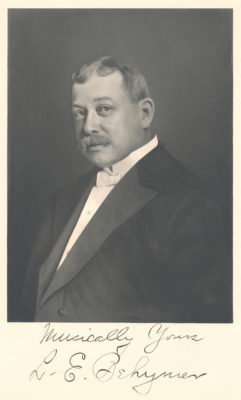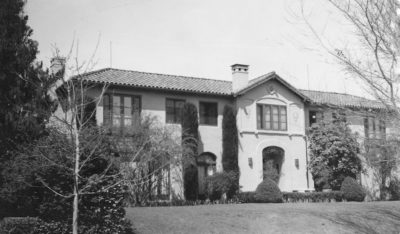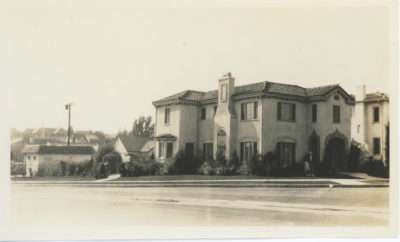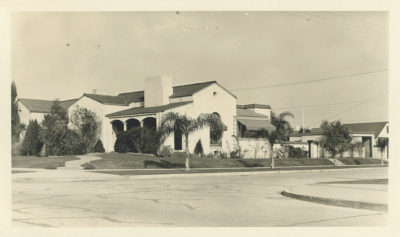The Behymer Family in Hancock Park, Brookside and Windsor Square

IMPRESSARIO L.E. Behymer produced cultural programming in Los Angeles for 50 years.
In last month’s Larchmont Chronicle, Larchmont Blvd. resident John Donley suggested that Chronicle readers might enjoy seeing periodic profiles of “someone in the neighborhood in which we’d get to know that person….” In this issue, because 1919 is the centennial of the founding of the Los Angeles Philharmonic Orchestra, we are profiling a local family — from the past — that was intimately involved in the founding of the orchestra and other matters musical in early Los Angeles.
The Windsor Square-Hancock Park neighborhood has played an important role in the lives of the descendants of pioneer Los Angeles music impresario Lynden Behymer, with these descendants having lived in local houses on June Street, Muirfield Road, Arden Boulevard, Poinsettia Place, Gramercy Place and Citrus Avenue.
Behymer descendants attended Third Street School, John Burroughs Junior High School, Los Angeles High School and Marlborough School. This is the story of that family and the founding of the Los Angeles Philharmonic Orchestra.
Dakota Territory origins
Lynden Ellsworth Behymer and his wife Menetta Sparkes met in the Dakota Territory in the 1880s, having ventured west from Shelbyville, Illinois, and Chautauqua County, New York, respectively. They married in January 1886, made a visit to see relatives in Shelbyville in May, and arrived in Los Angeles in June of 1886, thanks to the railroad fare wars, which made rail travel practically free.
As Menetta was due to give birth to their first child (Glen) in October, she made herself at home in their leased rooms in the heart of downtown Los Angeles. Behymer set off to find some income. Having been in the construction and retail business in the Dakotas, he found a job with a lumber mill.
Later on, due to the theatrical influences in his family and his love of books (especially classical literature), he found a day job at a bookstore and would work in any capacity in theaters at night.
Two more children entered the family in 1888 (Enid) and 1889 (Elsie). Both Behymer’s father and sister would soon join the family in Los Angeles.
Managing artists

GLEN BEHYMER residence at 661 S. June St.
By 1890, Behymer established himself as an artists’ manager with his presentation of Adelina Patti (French opera singer) in Mott Hall. The city was still small (about 50,000), and networking within the community was easily done. Both Mr. and Mrs. Behymer were well acquainted with the Chautauqua Assemblies (begun 1874 in New York) that traveled to communities and held summer sessions of learning in the arts (music, art, drama, literature) and athletic exercises.
“La Boheme”
Music captivated Behymer. Around 1896-97, he and his friend, Harley Hamilton, began planning for both a Los Angeles Symphony Orchestra and a Women’s Symphony Orchestra. Hamilton would conduct both of the music ensembles for their first 18 years. Behymer, in 1897, brought “La Boheme” to the Los Angeles Theater via an opera company from Turin, Italy — on a world tour just one year after Puccini composed “La Boheme.” (There was a Los Angeles Theater on Spring Street in the late 1800s. The parking structure of the former “Los Angeles Times” building now is at that location.) In 1901, Behymer welcomed the Metropolitan Opera Company from New York to again perform “La Boheme” — this time at Hazard’s Pavilion, across from Pershing Square, with Mme. Nellie Melba in her debut as Mimi and Miss Fritzi Scheff as Musetta.
Los Angeles Philharmonic

ENID BEHYMER MALCOLM home; Muirfield Road at 8th Street.
For 23 years, the Los Angeles Symphony Orchestra had sponsors, but the list sometimes varied from year to year, and the monies were not always the same. Mr. Behymer was more than thrilled when Mr. William Andrews Clark, Jr. approached him in 1918 to discuss Mr. Clark’s establishing an endowment for the formation of a philharmonic orchestra in Los Angeles. It was up to Behymer to search for a proper, well-known conductor and to assemble the orchestra, which he did. By early 1919, with the international assistance of Joseph Dupuy (a French-born tenor who moved to Los Angeles in 1888), Behymer contracted Walter Henry Rothwell as the conductor for 90 first-class musicians, many of whom came from the Los Angeles Symphony Orchestra. Mr. Behymer was the Los Angeles Philharmonic’s manager for its first four years.
Impresario
Thereafter, Behymer became the manager for seasonal grand opera and ballet and many individual artists for their Los Angeles and Southwestern United States engagements (i.e. Helena Modjeska, Paderewski, Fritz Kreisler, Jascha Heifetz, Ernestine Schumann-Heink, Lawrence Tibbett, Yehudi Menuhin, Nelson Eddy, Arthur Rubenstein, Marian Anderson and Lily Pons). He would present them in his Behymer Tuesday and Thursday Artist Courses (Series) at the Philharmonic Auditorium (Fifth and Olive), at the Trinity Auditorium (Ninth and Grand), at the Shrine Auditorium, as well as at the Hollywood Bowl (the original plans for which were once laid out in his son Glen’s living room). Menetta managed the box office while her husband managed the front and back of the theater.
Turn of the century

ELSIE BEYHMER MOODY residence on Arden Boulevard at 1st Street — built of adobe bricks.
The three Behymer children spent most of their youth in a home near 30th Street near today’s Downtown. They all attended Los Angeles High School, which was then located on Fort Moore Hill, just north of Bunker Hill. The family’s main source of transportation was the Red Car line, as the senior Behymers did not drive. Just before Enid entered high school, the family moved “west” to Carondelet St., just one block from Westlake (now MacArthur) Park, where they had boating parties.
June, Muirfield, Arden
After each child completed high school, it was off to college. Glen graduated from George Washington University and became a lawyer. He eventually moved to the 600 block of South June Street and raised his family. Enid and Elsie attended USC, where they met their husbands. Neither sister completed college. In 1911, Enid married a professor of political science, Roy Malcom (changed to Malcolm in the 1940s), and they lived for some time also on Carondelet. Eventually, their young family moved to Muirfield Road in the Brookside neighborhood. Elsie married her soldier husband Earl Moody, who had just received his medical degree in 1917. After he returned from World War I, they built their adobe-brick home at First and Arden.
Los Angeles High on Olympic Boulevard
Of the 11 grandchildren of Lynden and Menetta Behymer, eight attended Los Angeles High School, by then located on Olympic Boulevard at Rimpau. In the ’30s and ’40s, the school was a grand edifice of light-colored brick. Unfortunately, earthquake damage resulted in its demolition. One granddaughter attended Marlborough School. Another granddaughter, Lynn Moody, was the only grandchild to remain in the vicinity. She and her husband Ralph Hoffman first lived on Poinsettia Place (1947 to 1949), then Gramercy Place (1949 to 1954) and finally South Citrus Avenue from 1954 until her death in 2006. Her daughters (including the author) attended Third Street School and John Burroughs, as did their mother. The daughters matriculated from Marlborough School.
The home on Carondelet that the Behymer children and grandchildren loved so much burned in 1938. Lynden and Menetta moved to Kingsley Drive. After 50 years being known as the Los Angeles Music Impresario, Lynden Ellsworth Behymer died on Dec. 16, 1947, followed by his wife in 1958.
Lynn Moody Hoffman’s children and grandchildren now attend Los Angeles Philharmonic performances at the Walt Disney Concert Hall and continue the family tradition of going to the Hollywood Bowl every summer.
By Diane Hoffman Dixon
Category: Real Estate
